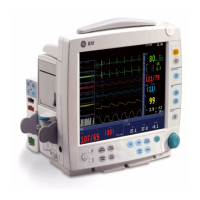B30 Patient Monitor
14-2
Display of invasive blood pressure
Figure 14-1 InvBP display
(1) Invasive blood pressure waveforms with zero and reference lines
(2) Selected pressure label
(3) Selected pressure scale
(4) Field for messages and alarm limit settings
(5) Systolic, diastolic and mean pressure values of invasive blood pressures
You can have a combined display of all those waveforms that are selected on the screen. This
combined display uses the whole waveform field area and the same zero line for all
waveforms.
To select:
1. Press the
Monitor Setup key and select Screen Setup.
2. Select Waveform Fields.
3. To combine all waveforms in one field, select Combine Pressures and Yes.
Patient connections
1. Connect the pressure transducer to the transducer adapter cable. Connect the cable to
the red connector in the module, or to the dual invasive blood pressure adapter cable.
NOTE: Invasive pressures need to be zeroed after reconnecting the pressure
transducer or cable, and whenever the patient’s position is changed. The transducer is
always leveled to the mid right atrium.
2. Prepare the transducer kit according to the manufacturer’s instructions. Mount the kit
with the transducer zeroing port at mid-heart level.
3. Ensure that there is no air in the line. Refer to transducer manufacturer’s instructions on
how to remove trapped air from the transducer.
4. Connect the patient catheter to the pressure line.
5. Open the dome stopcock to room air.
6. Zero the transducer. See “Starting with accurate values” on page 14-4.
7. Open the dome stopcock to pressure catheter and check the quality of the waveform.
WARNING Mechanical shock to invasive blood pressure transducer may cause severe
shifts in zero balance and calibration, and cause erroneous readings.
2
3
4
5
1

